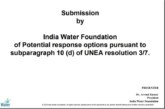Srijana Mitra Das|Times EVOKE|21 Nov 2020, 09:37 IST

Peter R Girguis is professor of organismic and evolutionary biology at Harvard University. Speaking to Srijana Mitra Das at Times Evoke, the distinguished scientist and oceanographer explains why the sea is vital to humanity:
Your writing sometimes refers to the ocean as ‘inner space’ — can you explain this?
‘Inner space’ is another way of thinking about the ocean. We frequently talk about exploring outer space. However, the exploration of outer space is actually easier than exploring the ocean. We can explore the cosmos using our eyes and optical instruments. You can look up on an evening and see the moon, which is hundreds of thousands of kilometres away. The ocean is just over 11 kilometres in depth and we still cannot see it. We are quick to think of exploring outer space — but there is this inner space that is far more challenging. At another level, the inner space of the ocean, the conditions of its salt water, are no different than the conditions in our own bodies. We humans are like containers of salt water — the salinity of our blood, our cells, the chemicals found in us, are also found in the ocean. Scientists have discovered that the beginnings of life were in water. In this way, the ocean runs through our veins.
What are the connections between marine microbes and what you term local and global biogeochemical cycles?
The ocean runs our planet — every breath we take has oxygen in it. Half of that oxygen comes from marine microbes. The other half comes from plants. Marine microbes therefore powerfully influence global biogeochemical cycles. This term represents how oxygen moves from the ocean to land, into the air, and then into people. Importantly, marine microbes also provide protein for one-fourth of humanity. They take nitrogen from the air and turn it into amino acids and protein — they
literally nurture us. Even the deepest of the deep sea provides nutrients. In the Indian Ocean, for example, surface waters are biodiversity hotspots. This is because of the cold, nutrient-rich water from the deep sea beyond the reaches of sunlight — that cold water comes to the surface and feeds algae. The algae feeds shrimp, which feeds fish. Thus, these extraordinary
ecosystems exist, fed by the deep sea.

The ocean has microbes that consume the majority of methane on earth. Methane is an even more potent greenhouse gas than carbon dioxide. This is tied up in the deep sea as methane ice — it’s a very strange material. It’s like ice but it is actually methane trapped as a solid. Methane sometimes emerges from the sea floor as bubbles or seepage. These microbes then eat
it. Certain sea animals have evolved a symbiotic relationship with such bacteria — these animals resemble clams or mussels, except they are about five to ten times larger. These don’t eat food like shallow mussels. Instead, they have evolved this relationship with bacteria that grow inside them. The mussels help deliver methane to the bacteria, which have a safe place to live in mussel tissue. The bacteria absorb the energy from this methane and feed themselves and the mussels. This astonishing relationship is hosted in methane seeps.
Worryingly, as more carbon dioxide now blankets the earth and temperatures rise, more and more of this methane is being released from the ocean, as well as the tundra, into the atmosphere. We have both methane producers and methane eaters. We don’t know who is faster but the answer holds profound meaning for our well-being.

Is human activity damaging even microbial marine ecosystems?
Human activity is having a very serious effect on ocean life — it is changing the conditions of our atmosphere through carbon emissions. All these gases dissolve in sea water, changing the oceans. This is especially true in the upper ocean currently —animal life is struggling to cope with ocean acidity and temperature change. These problems will soon impact humanity — over 25% of us depend on the ocean. From fishing to tourism, if you sum up all the economic activities the ocean supports, it would itself be in the G7. So, when we change the ocean, we are hurting multiple natural ecosystems and humanity.
How can ordinary people help the seas?
The first thing to do is to read about the ocean. We’re busy and often exhausted. But you can nourish your soul by reading about the oceans and the amazing creatures in them. A life truth is that the ocean is a part of us and we are a part of it. We should all learn more about it. Sometimes, people assume that you have to be an ocean scientist to help preserve the seas. That isn’t so. One of my classes at Harvard is open to all. It includes lawyers, programmers, engineers, students, retirees. I teach deep sea biology here. At the beginning of the course, people wonder, what can I do? At the end of it, they see they each have individual gifts they can offer. A computer designer can volunteer to help an ocean conservation group make an informative web page. An accountant can help a marine research group balance its budget. Everyone is skilled and our collective efforts can help others understand how without the ocean, this planet won’t be habitable for us. We must stop destroying this amazing and beautiful oceanic world — a place of antiquity which has been here from before humankind.

Post Source : https://timesofindia.indiatimes.com/the-oceans-give-us-oxygen-full-of-wondrous-antiquity-the-seas-run-through-humanitys-veins/articleshow/79328008.cms


